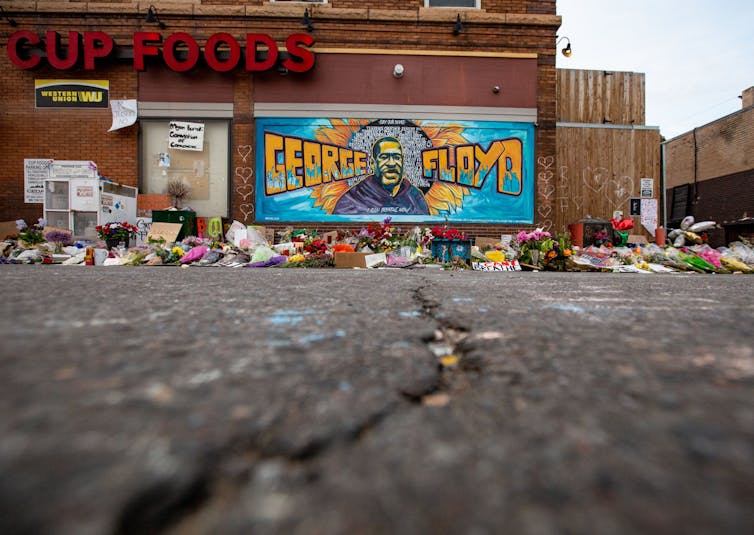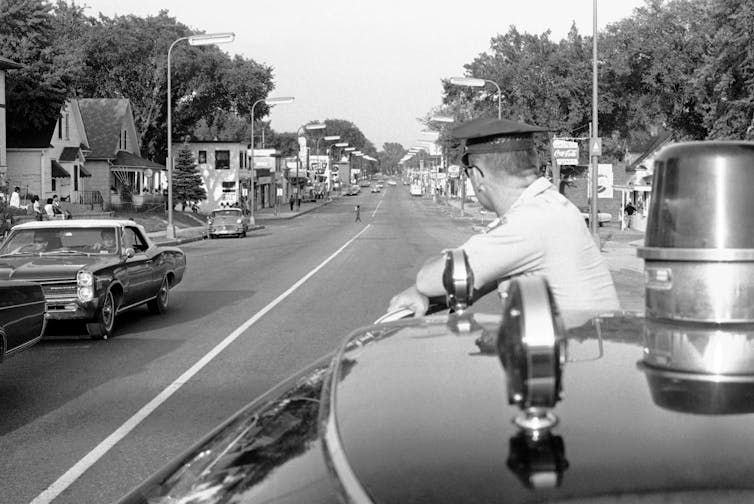The legacy of structural racism was laid bare at the intersection of Chicago Avenue and East 38th Street, writes Julian Agyeman.

By Julian Agyeman
Tufts University
 The legacy of structural racism in Minneapolis was laid bare to the world at the intersection of Chicago Avenue and East 38th Street, the location where George Floyd’s neck was pinned to the ground by a police officer’s knee. But it is also imprinted in streets, parks and neighborhoods across the city – the result of urban planning that utilized segregation as a tool of white supremacy.
The legacy of structural racism in Minneapolis was laid bare to the world at the intersection of Chicago Avenue and East 38th Street, the location where George Floyd’s neck was pinned to the ground by a police officer’s knee. But it is also imprinted in streets, parks and neighborhoods across the city – the result of urban planning that utilized segregation as a tool of white supremacy.
Today, Minneapolis is seen to be one of the most liberal cities in the U.S. But if you scratch away the progressive veneer of the U.S.‘s most cyclable city, the city with the best park system and sixth-highest quality of life, you find what Kirsten Delegard, a Minneapolis historian, describes as “darker truths about the city.”
As co-founder of the University of Minnesota’s Mapping Prejudice project, Delegard and her colleagues have been shedding new light on the role that racist barriers to home ownership have had on segregation in the city.
‘Racial Cordon’
Segregation in Minneapolis, like elsewhere in the U.S., is the result of historic practices such as the issuing of racialized real estate covenants that kept nonwhite people from buying or occupying land.
These covenants began appearing in U.S. cities from the early 1900s. Before their use in Minneapolis, the city was “more or less integrated, with a small but evenly distributed African American population.” But covenants changed the cityscape. Racist wording from the city’s first racially restrictive covenant in 1910 stated bluntly that the premises named “shall not at any time be conveyed, mortgaged or leased to any person or persons of Chinese, Japanese, Moorish, Turkish, Negro, Mongolian or African blood or descent.”
As a result, African Americans, especially, were pushed into a few small areas of the city such as the Near North neighborhood, leaving large parts of the city predominantly white. Some of the city’s most desirable parks were ringed by white residential districts. The result was an invisible “racial cordon” around some of the city’s celebrated parks and commons.

(AP/Robert Walsh)
‘By Design, not Accident’
As a scholar of urban planning, I know that Minneapolis, far from being an outlier in segregation, represents the norm. Across the U.S., urban planning is still used by some as the spatial toolkit, consisting of a set of policies and practices, for maintaining white supremacy. But urban planners of color, especially, are pointing out ways to reimagine inclusive urban spaces by dismantling the legacy of racist planning, housing and infrastructure policies.
Racial segregation was not the byproduct of urban planning; it was, in many cases, its intention – it was “not by accident, but by design,” Adrien Weibgen, senior policy fellow at the Association for Neighborhood and Housing Development, explained in a 2019 New York Daily News article.
The effect was and still is devastating.
The Urban Institute, an independent think tank, noted in a 2017 report that higher levels of racial segregation were linked to lower incomes for Black residents, as well worse educational outcomes for both white and Black students. Other studies have found that racial segregation leads to Black Americans being excluded from high-performing schools. In Minnesota – which ranks as the fourth most segregated state – the gap between the performance of white students and students of color is among the highest in the U.S. Likewise, segregation limits access to transportation, employment and quality health care.
Income & Wealth Gaps
According to the U.S. Census Bureau, in Minneapolis the median Black family income in 2018 was $36,000, compared to nearly $83,000 among white families. After Milwaukee, this is the biggest gap of the 100 largest metropolitan areas in the U.S. Mirroring the city’s income gap is a huge wealth gap. Minneapolis now has the lowest rate of homeownership among Black American households of any city.
Residential segregation in Minneapolis and elsewhere is still stubbornly high despite more than 50 years since the passing of the 1968 Fair Housing Act, which prohibited discrimination in the sale, rental and financing of housing based on race, among other factors. But while some residential segregation is now income-based, racial segregation across the U.S. is more ingrained and pervasive than economic segregation.
Zoning Out
Residential racial segregation continues to exist because of specific government policies enacted through urban planning. A key tool is zoning – the process of dividing urban land into areas for specific uses, such as residential or industrial. In the introduction to her 2014 book “Zoned in the USA,” urban planning professor Sonia Hirt argues that zoning is about government power to shape “ideals” by imposing a “moral geography” on cities. In Minneapolis and elsewhere, this has meant excluding “undersirables” – namely the poor, immigrants of color and African Americans.
With explicit racialized zoning long outlawed in the U.S. – the U.S. Supreme Court ended the practice in 1917 – many local governments instead turned to “exclusionary” zoning policies, making it illegal to build anything except single-family homes. This “back door racism” had a similar effect to outright racial exclusions: It kept out most Black and low-income people who could not afford expensive single-family homes.
In Minneapolis, single-family zoning amounted to 70 percent of residential space, compared to 15 percent in New York. Buttressing this, redlining – the denial of mortgages and loans to people of color by government and the private sector – ensured the continuance of segregation.
Anti-Racist Planning
Minneapolis is trying hard to reverse these racist policies. In 2018, it became the first large city to vote to end single-family zoning, allowing “upzoning”: the conversion of single-family lots into more affordable duplexes and triplexes.
This, together with “inclusionary zoning” – requiring that new apartment projects hold at least 10 percent of units for low- to moderate-income households – is part of the Minneapolis 2040 Plan. Central to that vision is a goal to eliminate disparities in wealth, housing and opportunity “regardless of race, ethnicity, gender, country of origin, religion, or zip code” within 20 years.
In the aftermath of George Floyd’s death, Minneapolis City Council acted quickly in advancing plans to dismantle the city’s police force. Dismantling the legacy of by-design segregation will require the tools of urban planning being utilized to find solutions after decades of being part of the problem.![]()
Julian Agyeman is professor of urban and environmental policy and planning at Tufts University.
This article is republished from The Conversation under a Creative Commons license. Read the original article.
The views expressed are solely those of the author and may or may not reflect those of Consortium News.
Please Contribute to Consortium
News on its 25th Anniversary
Donate securely with  PayPal here.
PayPal here.
Or securely by credit card or check by clicking the red button:

Up-zoning is not a tool for creating racial equity, it’s a tool for allowing real estate interests to get their hands on land currently occupied by older homes. It drives up the cost of housing by forcing families to compete with developers willing to pay a high price for the right to demolish existing housing and redevelop the property. When the justification for this policy isn’t equity, it’s sustainability, but, left in the hands of real estate investors, construction materials are chosen for profitability, not durability, and every demolition releases toxic chemicals as, in some cases, original hardwoods are turned into landfill. What we’re seeing where I live is a reduction in green space as new, larger buildings are built as close as possible to lot lines, a proliferation of boxy, half-empty apartment buildings with expensive micro-apartments, an increase in housing owned by private equity companies, and a homogenization of distinctive urban spaces. And guess which areas are excluded from up-zoning? Yes, the areas occupied by the truly wealthy of this city, including many of the developers making a killing at our expense. Instead of cynically using historic redlining to push through unpopular policies or giving investors “incentives” to add a few affordable units to their developments, politicians could tax wealth to build high-quality public housing in the short term and enact policies that prevent the unequal distribution of wealth in the long term. Now, that would reverse the effects of redlining without turning our cities over to outside investors.
I appreciate this piece because it highlights past mistakes (to say the least) and then talks about some possible solutions.
I think there could be some big houses out there in need of some “zoning re-definition” – in fact, I’m sure there are. I suspect there is a lot of unused space that ought be opened up.
The word for what we’ve been seeing in recent decades is “gentrification.” It is, and has been, about class, not race. The purpose has been to uproot poor communities, remove the people, and establish new solidly middle class communities in their place.
I think the cost of living is quite high in cities like that, which is an enormous barrier to home ownership. And in many northern blue state big cities like Chi-town, Brew City and Detroit, taxes are also sky high – state income, sales, and property tax, compared to southern cities. So even though they present a veneer of progressive inclusion, the basics of social mobility are impossible given that. And remember the cost of a heating bill in a polar vortex? Not cheap. These bills add up fast. And don’t get me started on the cost of health care, but w/o Medicare for all, everybody is screwed who is trying to “afford” a home and maintain it. Just getting sick once can kill the dream – thanks Republicans AND Democrats!! And we have to mention the sub-prime mortgage crimes leading up to the ’07 economic collapse, disproportionately exploiting blacks, and the absolute impunity those dirty deeds were dealt with, we all know who was in charge of that. We are well over a DECADE after that damn scandal, and our property STILL has not recovered to what it was in value – it’s highway robbery, watching stocks hit record highs in the meantime? It’s a cruel joke. But our taxes are terribly high again, even higher than before. Nothing has changed in this whole situation, nor will it in the next four years, people are naïve if they think it will. Probably poverty will get a lot worse. The locals get it, when they booed little Jacob Frey at the protest for his status quo support, they were right on.